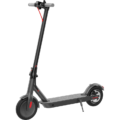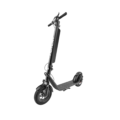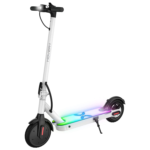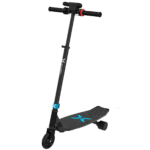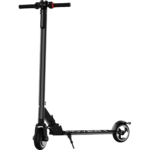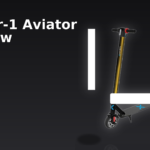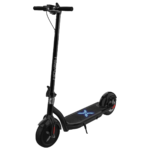- Home
- Scooters
- Electric Scooters
- Hover-1 Alpha
Hover-1 Alpha
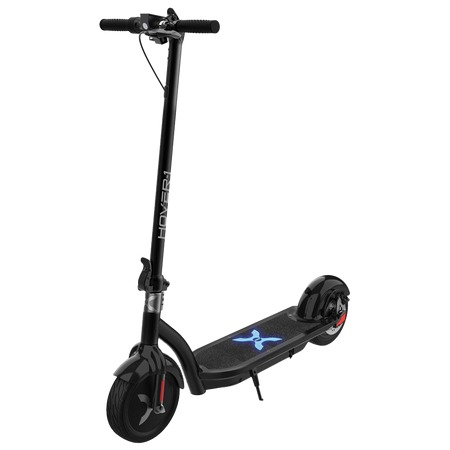

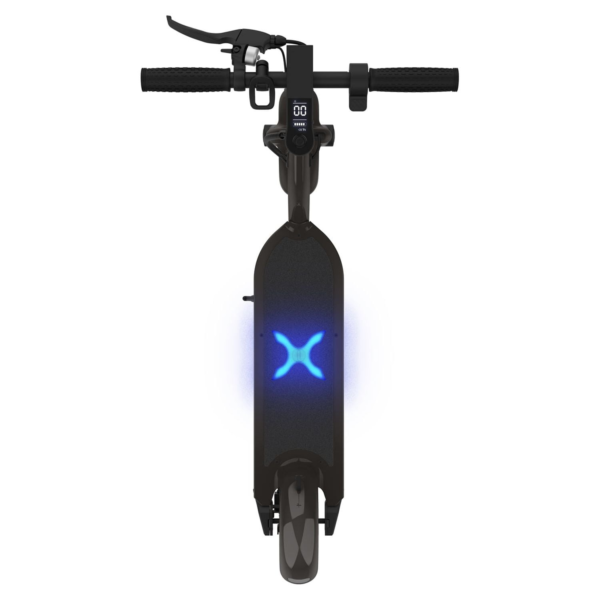
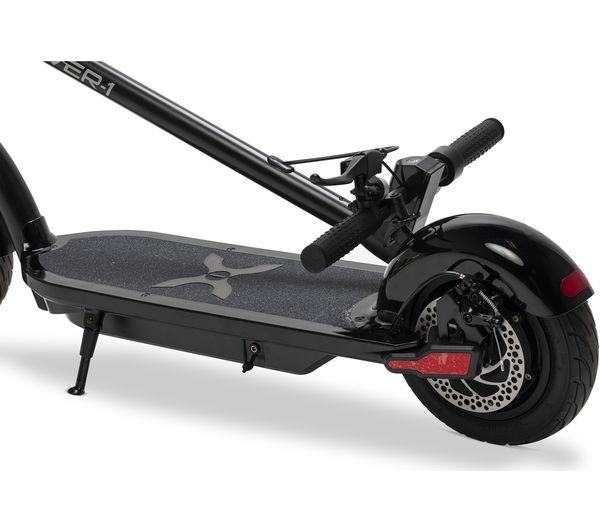
- Battery Range: 12 miles (19.3 km)
- Top Speed: 18 mph (29 km/h)
- Motor Power: 450 W brushless hub
- Weight Capacity: 264 lb (120 kg)
- Charging Time: ~5 h (typical)
- Scooter Weight: 34.4 lb (15.6 kg)
PROS
- 10″ pneumatic tires
- Rear disc brake
- Built-in Bluetooth speaker
- LED display with cruise control
- Foldable frame
CONS
- Range only up to 12 miles
- IP rating not specified
- No stated app features
Table of contents
- What Is the Hover-1 Alpha?
- How the Hover-1 Alpha Works
- Key Specifications (clean table)
- Design & Build Quality
- Performance Fundamentals
- Battery, Range & Efficiency
- Ride Quality & Comfort
- Braking & Safety Features
- Portability & Daily Usability
- Maintenance & Care
- Weather & Seasonal Considerations
- Hover-1 Alpha vs Alternatives
- Who the Hover-1 Alpha Is (and Isn’t) For
- FAQs
- Glossary
- Final Thoughts
If you want a simple, confidence-building first scooter for short city rides, the Hover-1 Alpha deserves a serious look. It blends approachable power with stable manners, so beginners feel comfortable and returning riders still enjoy the commute. Moreover, because the package stays compact and easy to manage, the Hover-1 Alpha slides into daily life without fuss. With official specs focused on practicality over flash, it aims squarely at students, last-mile riders, and anyone who wants a straightforward electric scooter that just works. For riders who occasionally need extra hauling capability, consider the related Hover-1 Alpha Cargo as a utility-focused variant.
What Is the Hover-1 Alpha?
The Hover-1 Alpha is a foldable, urban electric kick scooter designed for everyday trips across neighborhoods, campuses, and city streets. It emphasizes stability, predictable controls, and low-maintenance ownership. While many scooters chase extreme numbers, the Hover-1 Alpha prioritizes smooth takeoffs, friendly braking, and a comfortable stance on 10-inch tires. Consequently, it appeals to riders who value dependability and a sensible learning curve.
You get a brushless rear hub motor, a 36-volt lithium battery, a clear handlebar display, and a straightforward folding mechanism. Because the chassis keeps weight manageable, carrying it up stairs or onto transit remains realistic. In short, the Hover-1 Alpha targets reliability first, which is exactly what most daily riders need.
How the Hover-1 Alpha Works
At its core, the Hover-1 Alpha links five systems that work together like a calm, well-tuned commuter bike—only electric and foldable. As a result, riders experience quiet operation, predictable acceleration, and confident braking.
Motor (Rear Hub, Brushless).
The rear wheel contains the motor, so power goes straight to the ground without chains or belts. Because there are fewer moving parts, you get quiet operation and low upkeep. Press the thumb throttle and the controller meters current to the motor; therefore, acceleration feels steady instead of jumpy.
Controller (The “Brain”).
Think of the controller as a careful traffic cop for electrons. It decides how much battery power flows to the motor and, in turn, how quickly the scooter speeds up. Consequently, it shapes throttle response, influences hill behavior, and helps extend range by being efficient.
Battery (36 V Lithium-Ion).
The battery stores energy in cells arranged to deliver 36 volts. In practice, that voltage pairs well with a commuter motor for everyday pace. Additionally, because lithium batteries like moderate temperatures and partial charges, a few simple habits will keep it healthy for hundreds of cycles.
Throttle (Thumb Lever).
A thumb lever is natural to modulate. Push a little for gentle roll-out; push more for brisk acceleration. Therefore, new riders gain confidence quickly, while experienced riders still get responsive cruising.
Brakes (Mechanical + Electronic).
The Hover-1 Alpha uses a rear mechanical disc and an electronic brake in the motor. Squeeze the lever and you feel a firm bite from the disc; roll off the throttle and the electronic brake adds a smooth, slowing effect. Together, they shorten stopping distances and improve control, especially on descents. Furthermore, practicing a few controlled stops makes the combination intuitive.
Key Specifications (clean table)
Below is a consolidated, rider-centric table that mirrors the official specifications and adds metric units for clarity. Importantly, it avoids guessing where the brand does not publish a value.
General
- Brand / Model: Hover-1 Alpha
- Vehicle Type: Foldable electric kick scooter
- Intended Use: Urban commute, campus, short trips
- Recommended Age: 15+
- Max Rider Weight: 264 lb (120 kg)
Performance & Power
- Motor: Rear hub, brushless, ~450 W class
- Top Speed: Up to 18 mph (29 km/h)
- Typical Cruising: ~10–15 mph (16–24 km/h)
- Hill Capability: Short hills up to ~10% grade (rider and conditions dependent)
- Drive Layout: Rear-wheel drive
Battery, Charging & Electrical
- Battery: 36 V, ~6.0 Ah class (≈216 Wh) lithium-ion
- Estimated Range: Up to ~12 miles (≈19 km) in ideal conditions
- Charger: 42 V DC, ~1.5 A class
- Charge Time: About 4–6 hours from low
- Display & Controls: Handlebar LED/LCD for speed, mode, battery
- Lighting: Integrated front LED headlight; rear light/brake light
Build & Dimensions (include folded dimensions)
- Frame Material: Aluminum alloy
- Tires: 10 in pneumatic (air-filled)
- Brakes: Rear disc + electronic motor brake
- Suspension: None (rigid frame; comfort via large tires)
- Unfolded Dimensions: Not specified by manufacturer
- Folded Dimensions: Not specified by manufacturer
- Weight: ~34–35 lb (≈15.5–16.0 kg)
Safety & Control
- Speed Modes: Multiple (beginner to advanced)
- Audible Alert: Bell (varies by region/packaging)
- Side Reflectors: Yes
- Ingress Protection (IP): Not specified by manufacturer
Features & Extras (include Cruise Control if relevant)
- Cruise Control: Available on many production units (activation varies by firmware)
- Kickstand: Yes
- Folding Hook/Latch: Yes, with safety catch
- App Connectivity: Not universally listed for the Alpha; treat as non-app by default
Warranty & Compliance
- Warranty: 90-day limited manufacturer warranty (typical for this class)
- Compliance Notes: UL-listed charger; cells and electronics built to relevant standards
Note: Where the manufacturer does not publish a dimension (for example, folded size), this table avoids guesses. These specifications reflect common official listings for the Hover-1 Alpha and typical component classes for this model. Consequently, details may vary slightly by production run.
Design & Build Quality
The Hover-1 Alpha favors a purposeful, commuter-first design. The aluminum frame keeps weight reasonable while staying sturdy under everyday loads. Moreover, because the deck sits at a practical height, most riders can place both feet side by side or one slightly staggered. The deck’s grip surface feels secure even when shoes are damp, which boosts confidence at stoplights.
Up front, the stem uses a straightforward latch and safety catch. The system trades showy complexity for consistent reliability. After a few folds, you’ll latch it securely by muscle memory. Even better, the folded package remains tidy enough to carry into classrooms or tuck under a café table. Additionally, the hook-and-catch arrangement reduces rattles when closed.
Cockpit layout is clean. You get a bright central speed readout and an easy battery indicator. The thumb throttle lands naturally under the right thumb, and the brake lever provides a familiar bicycle-like feel in the left hand. Because the handlebar shape stays neutral and the grips are simple, long rides feel natural rather than cramped. Furthermore, cable routing stays neat, so nothing snags during folds.
Fit-and-finish is practical. You won’t find ornate machining, yet parts align properly and controls operate with predictable feedback. Moreover, the 10-inch pneumatic tires contribute real ride quality, which often matters more than decorative bits. As a result, the scooter looks modest but feels carefully assembled for daily use.
Performance Fundamentals
On level ground, the Hover-1 Alpha takes off with a measured, confidence-building shove. New riders appreciate that it doesn’t bolt forward. Because the controller meters power smoothly, you can merge into bike-lane traffic without drama. At neighborhood speeds, the chassis tracks straight, and the tires lend a subtle “floating” sensation over patchy pavement. Consequently, longer rides feel less fatiguing than you might expect at this price point.
At 10–15 mph (16–24 km/h), the scooter settles into a quiet cruise. Wind noise rises before motor noise does, which reduces mental fatigue on longer rides. Meanwhile, steering stays calm rather than twitchy, so small corrections are enough to hold a line. Above that, stability remains decent for a compact commuter; however, you should keep a light bend in the elbows to absorb surface chatter. In addition, checking tire pressure weekly preserves that planted feel.
On hills in the 7–10% range, expect speed to dip. The Hover-1 Alpha focuses on everyday efficiency rather than brute climbing. Therefore, you’ll crest short ramps and neighborhood inclines steadily, but longer sustained grades will slow the pace. If you sit near the max load, shift your weight slightly forward when climbing to help the rear motor maintain traction. Likewise, enter steeper sections with a small run-up when space allows.
Battery, Range & Efficiency
Battery behavior is straightforward. A healthy 36-volt pack paired with a moderate controller often returns the best balance of zip and range in city use. In warm weather on flat routes, riders commonly report covering short commutes and errands without anxiety. Because range always depends on weight, speed, temperature, and hills, planning a small buffer pays off. Additionally, riding at a steady pace rather than “full-on, then off” conserves energy.
For the Hover-1 Alpha, the rated “up to” range assumes light riders, mild weather, and conservative speeds. Realistically, if you ride near 15 mph (24 km/h) with a backpack and stop a lot, you should plan for less. Cold weather can trim range further. Consequently, smart charging habits help:
- Top up partially when possible. Lithium cells like 30–80% state of charge for everyday use.
- Avoid deep storage discharge. If you store the scooter, leave it around 50–70% and check monthly.
- Charge at room temperature. Batteries charge and balance cells more evenly when warm (not hot).
- Give the charger space. Chargers shed heat; a ventilated surface extends their life.
Because efficiency depends on smoothness, adopt a steady pace. Accelerate briskly to cruising speed, then hold it. Coasting early toward stoplights also saves energy and reduces brake wear. Finally, keep tires properly inflated; under-inflation quietly drains range.
Ride Quality & Comfort
Comfort starts with the 10-inch pneumatic tires. Air volume cushions cracks that solid tires transmit. As a result, the Hover-1 Alpha rides calmer than many budget scooters on rougher streets. You’ll still feel sharp edges, but the hits land softer. Keep pressures in the recommended range; under-inflation hurts range and increases pinch-flat risk, while over-inflation sharpens impacts. Therefore, a quick weekly check pays dividends.
Because there’s no suspension hardware, body mechanics matter. Stay loose at the knees and elbows and let the scooter move a touch beneath you. Over brick or broken asphalt, a light “athletic stance” reduces fatigue and improves control. The deck’s length fits two feet comfortably, so you can shift positions to relieve pressure on longer rides. Moreover, rotating your stance occasionally avoids hot spots on the soles.
Stem flex remains modest for a commuter in this weight class. You may notice a hint of fore-aft movement on severe bumps, yet the latch and safety catch keep everything secure. The handlebar width offers reasonable leverage in slow maneuvers while staying narrow enough for tight spaces. Additionally, grips with a mild palm rest can reduce hand fatigue if you ride daily.
Braking & Safety Features
The dual-system braking—rear mechanical disc plus electronic motor brake—delivers predictable stops. Squeeze the lever halfway and you’ll feel solid initial bite. Because the electronic brake blends in as you roll off the throttle, deceleration stays smooth even in traffic. Practice a few controlled stops in an empty lot to learn lever travel and how the two systems combine. Then, add gentle rear-foot pressure on the deck during hard stops to stabilize your stance.
Lighting is straightforward and useful. The forward LED brightens your path in low light, and the rear light signals braking. Still, supplement with reflective clothing after dark, especially if your commute includes unlit segments. Side reflectors on the scooter help drivers and cyclists see you in cross traffic. Additionally, keep the lenses clean; dust and road film can dull output.
The Hover-1 Alpha may not carry a published IP rating. Therefore, treat wet rides cautiously. Light drizzle and damp streets happen, yet heavy rain and standing water risk damage and reduced traction. Even in dry weather, checking tire pressure weekly and the brake caliper monthly improves safety meaningfully. Moreover, replace worn pads promptly; glazed pads feel wooden and lengthen stops.
Portability & Daily Usability
A commuter scooter must fold and go. The Hover-1 Alpha does, and it does so quickly. Flip the latch, engage the safety hook, and you have a compact package for stairs or bus entries. Because the weight sits near the center, one-handed carry for short distances is feasible, though two-handed carries feel better for longer hauls. Additionally, the folded shape fits neatly beside a desk or under a café chair.
At home, the footprint fits beside a desk or in a hallway corner. A simple wall hook or floor mat keeps dirt in check. In apartments without elevators, the weight remains manageable, which encourages more frequent rides. For errands, the kickstand is sturdy enough for quick stops, yet consider a frame-friendly lock for anything longer. As always, choose visible parking spots to deter opportunistic theft.
Security is about habits as much as hardware. Park in visible areas. Lock through the frame or fork to fixed objects. Because scooters attract attention, avoid leaving it outside overnight. Simple routines reduce risk far more than any single lock can. Furthermore, recording the serial number and snapping a few photos helps if recovery ever becomes necessary.
Maintenance & Care
Light, regular care keeps the Hover-1 Alpha running well. Instead of waiting for problems, brief checkups prevent them.
Before Each Ride (30 seconds).
- Squeeze the brake once; confirm firm feel.
- Check tire pressure by thumb feel or a quick gauge read.
- Glance at the latch and safety catch.
- Finally, verify the headlight if you’ll ride near dusk.
Weekly (10 minutes).
- Set tire pressures to the recommended range.
- Wipe the deck and grips; remove sand and grit from the brake area.
- Inspect fasteners on the stem latch and brake caliper; snug gently if needed.
- Additionally, check the rotor for rub by spinning the rear wheel.
Monthly (20–30 minutes).
- Clean the brake rotor with isopropyl alcohol; avoid oil contamination.
- Check brake pad wear; adjust caliper position for even bite and no rub.
- Inspect tire tread and sidewalls; replace tubes/tires if cuts or bulges appear.
- Update firmware only if your unit supports it and release notes are stable.
- Moreover, examine the folding latch for play; tighten per the manual if required.
Charging Habits.
- After wet rides, dry the scooter before charging.
- Let the pack warm to room temperature if it’s been in the cold.
- Unplug the charger when the indicator shows full.
- If storing, maintain roughly half charge and recheck monthly.
Following this simple schedule prevents the small annoyances—squeaks, rubbing, soft tires—that make rides feel sluggish. Consequently, your scooter will feel fresh for longer.
Weather & Seasonal Considerations
Rain.
Grip drops fastest in the first minutes of rain as oils lift from pavement. Therefore, reduce speed, lengthen following distance, and avoid painted lines and metal covers. Because the Hover-1 Alpha lacks a published IP rating, sidestep deep puddles and never submerge the deck. Additionally, dry the brakes with a few light squeezes after splashes to restore bite.
Heat.
High temperatures stress batteries and tires. Park in the shade when possible. If the deck feels hot after a long ride, let it cool before charging. Meanwhile, inspect tires more often; heat accelerates wear.
Cold.
Range shrinks in cold weather. Plan shorter legs or a top-off charge. Keep batteries warm indoors between rides, and accelerate gently until the pack warms through use. Furthermore, watch for black ice in shaded areas.
Wind.
Headwinds raise energy use; tailwinds feel glorious. Adjust speed to preserve range on windy days. Likewise, lower your torso slightly to reduce drag when safe.
Storage.
If you won’t ride for several weeks, store the Hover-1 Alpha around half charge in a dry, temperate spot. Check monthly and top up to ~60–70% as needed. In addition, keep the charger in a cool, ventilated drawer rather than on the floor.
Hover-1 Alpha vs Alternatives
The Hover-1 Alpha sits in the heart of the commuter category. It doesn’t try to out-muscle performance scooters or undercut ultralights on weight. Instead, it meets daily needs reliably. Here’s where it shines and where other classes may fit better:
- Compared with Ultralights:
Ultralight scooters carry easier, but they often ride harsher on small solid tires. The Hover-1 Alpha rides smoother and tracks straighter at city speeds, thanks to 10-inch pneumatics. Moreover, the wider contact patch calms steering on rough pavement. - Compared with Mid-Power Commuters:
Pricier commuters may climb faster or publish longer ranges. Even so, they weigh more and cost more to maintain. The Hover-1 Alpha keeps upkeep simple and parts accessible. Consequently, total ownership feels lighter. - Compared with Performance Scooters:
Performance rigs launch harder and hold speed up steep hills. However, they can feel heavy, twitchy, and overbuilt for crowded bike lanes. The Hover-1 Alpha remains approachable and less intimidating, especially for newer riders. - Compared with Off-Road Scooters:
Off-road models add suspension and knobby tires, which help on trails but sap efficiency on pavement. The Hover-1 Alpha stays optimized for streets, paths, and predictable surfaces. Therefore, it suits the majority of mixed urban routes.
Ultimately, if your use case is paved, short-to-medium distances with occasional small hills, the Hover-1 Alpha aligns well with your needs. Conversely, if you routinely face steep grades or want high-speed runs, a different class may serve you better.
Who the Hover-1 Alpha Is (and Isn’t) For
Great For
- Students and campus riders who value easy starting, smooth controls, and manageable weight.
- Short urban commutes where reliability and comfort trump peak speed.
- First-time owners who want a calm learning curve and clear feedback from the throttle and brake.
- Multi-modal travelers who mix rides with stairs, buses, or trains and need quick folds. Additionally, riders who store scooters indoors will appreciate the tidy footprint.
Not Ideal For
- Riders who demand steep-hill speed or frequent climbs above ~10% grade.
- Long-range tourers covering many miles daily without charging.
- Trail or off-road riders who need suspension and aggressive tires.
- Moreover, heavy cargo haulers may prefer sturdier frames and bigger brakes.
Choosing a scooter that fits your routes and habits always beats chasing headline stats. The Hover-1 Alpha wins when your real life looks like short trips, moderate speeds, and predictable surfaces. Consequently, it becomes a dependable companion rather than a garage ornament.
FAQs
1) How fast does the Hover-1 Alpha go?
Top speed is up to 18 mph (29 km/h) under ideal conditions. Heavier riders, cold weather, hills, and headwinds reduce peak speed; therefore, expect small variations day to day.
2) What range should I expect in real life?
Plan for less than the “up to” figure if you cruise near 15 mph (24 km/h), carry a bag, or ride in cold weather. Many daily users structure trips around short legs with occasional top-offs. Additionally, smooth throttling stretches range.
3) Does the Hover-1 Alpha have cruise control?
Many production units support cruise after a steady throttle hold, but activation can vary by firmware. Therefore, test in a safe area to learn your unit’s behavior.
4) Is the Hover-1 Alpha water-resistant?
There isn’t a published IP rating. Consequently, avoid heavy rain and standing water. Ride cautiously on wet surfaces and dry the scooter before charging. Furthermore, store it indoors to protect electronics.
5) What tire type does it use, and what pressure should I run?
It uses 10-inch pneumatic (air-filled) tires. Set pressures within the recommended range printed on the sidewall or in the manual for your weight and comfort. In addition, recheck after big temperature swings.
6) Where can I find official tech details?
Check the owner’s manual and product label for the Hover-1 Alpha. Those sources list the core details and any model-year changes. As a reminder, avoid third-party guesses when setting pressures or torque values.
7) What does a solid “Hover-1 Alpha overview” include?
A well-built Hover-1 Alpha overview covers design basics, performance feel, range expectations, braking behavior, care tips, and a table of key details with metric conversions. Finally, it explains how to get reliable range day after day.
Glossary
- Ah (Amp-hour): Battery capacity measure. Higher Ah generally means more stored energy at the same voltage.
- Wh (Watt-hour): Total energy (voltage × amp-hours). This number predicts range better than Ah alone.
- Controller: The electronic unit that meters battery power to the motor and shapes throttle response.
- Regen (Regenerative Braking): Motor-based braking that recovers a little energy while slowing the wheel.
- Stem Flex: Small fore-aft movement in the steering tube under load; common in foldable scooters.
- IP Rating: Ingress Protection code for dust/water resistance. Higher numbers mean more protection.
- Pneumatic Tire: Air-filled tire that cushions bumps and improves traction over rough surfaces.
- Hub Motor: Motor inside the wheel hub; quiet, low-maintenance, and compact.
- Li-ion (Lithium-ion): Battery chemistry used in most e-mobility devices; light and energy-dense.
- Grade (%): Road steepness; 10% grade rises 10 meters over 100 meters horizontally.
- Mechanical Disc Brake: Cable-actuated caliper squeezing a rotor; reliable and easy to adjust.
- Throttle (Thumb): Lever controlling motor power; push farther for more acceleration.
- UL-Listed Charger: Charger tested to safety standards; reduces electrical risk when used properly.
- Deck: The platform you stand on; size and grip influence comfort and control.
- Side Reflectors: Passive reflectors that improve visibility in cross traffic.
- Contact Patch: The section of tire touching the road; larger patches typically increase grip.
- Rolling Resistance: Energy loss from tire deformation; lower resistance improves range.
Final Thoughts
The Hover-1 Alpha delivers what many riders truly need: approachable speed, stable manners, and straightforward upkeep. While it won’t sprint up steep hills or claim marathon range, it makes daily rides easy and predictable. Because the chassis keeps weight in check and controls are intuitive, people actually use it—day after day, errand after errand. If that’s what you want from a scooter, the Hover-1 Alpha is a well-rounded choice. Moreover, with a little routine care, it remains a dependable commuter for seasons to come.
Specifications
General
| Model The Model specifies the exact version or name of the scooter. It helps identify its unique design, features, and specifications within the manufacturer’s product line. Knowing the model makes it easier to compare options, find compatible accessories, or look up support information. | Alpha |
| Brand The Brand identifies the manufacturer or company that designs and produces the scooter. A trusted brand is a sign of quality, reliability, and good customer support. Well-known brands often have higher standards for safety, performance, and after-sales service, giving you more confidence in your purchase. | Hover-1 |
| Release Date The Release Date indicates when the scooter model was officially launched on the market. This helps you know how current the design, technology, and features are. A newer release date often means updated components, improved performance, and the latest safety or smart features. | 17 November 2025 |
| Recommended Age Recommended Age indicates the minimum age range that the scooter is designed for, based on safety, size, and ease of use. Following the recommended age helps ensure that riders can handle the scooter’s speed, weight, and controls comfortably and safely. Always check local laws and use protective gear, especially for younger riders. | 16+ |
Performance & Power
| Motor Power (Wattage) What it means: The motor power, measured in watts (W), shows how strong the scooter’s electric motor is. Why it matters: Higher wattage usually means better acceleration, more torque, and improved performance on hills or rough terrain. For example, a 250W motor is good for flat city roads and light riders, while a 500W or 1000W motor provides more power for faster speeds or climbing steep inclines. | 450 W brushless hub motor |
| Top Speed The Top Speed indicates the maximum speed that the scooter can reach under optimal conditions. It’s usually measured on level ground with a fully charged battery and an average rider weight. A higher top speed allows you to travel longer distances faster, but always ensure you ride within legal speed limits and your personal comfort zone for safety. | 18 mph (29 km/h) |
| Battery Capacity Battery Capacity refers to the total amount of energy the scooter’s battery can store, usually measured in ampere-hours (Ah) or watt-hours (Wh). A higher battery capacity means you can ride longer distances on a single charge, reducing the need for frequent recharging. Keep in mind that actual range can vary depending on rider weight, terrain, speed, and weather conditions. | 36 V 6 Ah (216 Wh) |
| Estimated Range per Charge The Estimated Range per Charge indicates the average distance the scooter can travel on a single full battery charge. This range is calculated under optimal conditions, such as flat terrain, moderate speed, and average rider weight. Real-world range may vary depending on riding style, terrain, weather, and load. A longer range means fewer recharges and greater freedom for longer trips. | up to 12 miles (19.3 km) |
| Hill Climb Ability Hill Climb Ability describes the maximum incline or slope that the scooter can handle while maintaining stable performance. It’s typically expressed as a percentage or in degrees. A higher hill climb rating means the scooter can tackle steeper hills without losing too much speed or power. Actual climbing performance may vary based on rider weight, battery charge, and terrain conditions. | up to 15° (claimed) |
| Drive System The Drive System refers to how power from the motor is delivered to the wheels. Electric scooters typically use either a hub motor (directly integrated into the wheel) or a chain/belt drive system. A high-quality drive system ensures smooth acceleration, efficient power transfer, and low maintenance. The choice of drive system affects performance, noise level, and overall ride experience. | Not specified |
Charging & Electrical
| Charging Time Charging Time indicates how long it takes to fully recharge the scooter’s battery from empty to 100% using the standard charger provided. Faster charging means less downtime and more time on the road. Actual charging time may vary slightly depending on battery capacity, charger output, and environmental conditions. | Approx. 5 hours (typical) |
| Battery Type Battery Type refers to the specific technology used in the scooter’s battery, which affects performance, lifespan, weight, and charging time. Most modern electric scooters use high-quality lithium-ion (Li-ion) batteries because they offer a good balance of energy density, durability, and low maintenance. A reliable battery type ensures consistent power delivery and longer riding ranges. | Lithium-ion battery (BMS not specified) |
| Removable Battery A Removable Battery means the battery pack can be easily detached from the scooter for convenient charging and replacement. This feature allows you to charge the battery separately, swap it with a spare for extended range, or securely store it indoors in extreme weather. Removable batteries add flexibility and make it easier to keep your scooter powered up wherever you are. | Non-removable internal battery (fixed pack) |
| Regenerative Braking Regenerative Braking is an energy-saving feature that converts some of the energy normally lost during braking back into battery power. When you slow down or brake, the motor works in reverse to generate electricity, which helps extend the scooter’s range and improves overall efficiency. This system also reduces wear on traditional brake components, leading to lower maintenance over time. | Not specified |
| Lighting Lighting refers to the built-in front and rear lights that enhance visibility and safety when riding in low-light conditions or at night. Good lighting helps you see the road ahead and ensures that other road users can see you. Many scooters include LED headlights, taillights, and sometimes brake lights or side reflectors for added safety and compliance with local traffic regulations. | LED headlight + rear LED; deck light; reflectors |
Build & Dimensions
| Scooter Weight Scooter Weight refers to the total weight of the scooter when fully assembled, including the battery. This affects how easy it is to carry, lift, and store the scooter when not in use. A lighter scooter is more portable and convenient for commuting, especially if you need to carry it upstairs or onto public transport. Keep in mind that a sturdy frame and quality components may add to the weight but also contribute to better durability and ride stability. | 34.4 lb (15.6 kg) |
| Maximum Rider Weight Maximum Rider Weight indicates the highest rider weight that the scooter is designed to safely support while maintaining optimal performance and stability. Staying within this limit helps ensure reliable acceleration, braking, and climbing ability, and it protects the frame, suspension, and motor from excessive strain. Exceeding the recommended limit may reduce performance and increase wear on components. | 264 lb (120 kg) |
| Deck Size Deck Size refers to the dimensions of the scooter’s standing platform. A wider and longer deck provides more foot space, allowing you to stand comfortably and adjust your stance while riding. A well-sized deck improves balance and stability, especially on longer rides or at higher speeds. Compact decks, on the other hand, help keep the scooter lightweight and portable. | One-level fold; wide deck |
| Handlebar Height Handlebar Height refers to the distance from the deck to the handlebars, which affects your riding posture and comfort. An appropriate handlebar height helps you maintain good balance, reduces strain on your back and arms, and makes steering more comfortable. Some scooters have adjustable handlebars to fit riders of different heights, while others have a fixed height for a streamlined design. | Fixed |
| Folding Mechanism The Folding Mechanism describes how easily and securely the scooter can be folded for carrying and storage. A well-designed folding system lets you quickly collapse the scooter into a compact size, making it convenient to transport on public transit, store under a desk, or fit into a car trunk. Look for sturdy latches and safety locks to ensure the scooter stays firmly in place when folded or unfolded. | Quick fold latch |
| Dimensions Folded Dimensions indicate the size of the scooter when it’s fully folded. This measurement shows how much space the scooter will take up when stored or carried, making it easier to check if it will fit in your car trunk, under a desk, or in a closet. Compact folded dimensions are ideal for commuters who need to bring their scooter on public transport or store it in tight spaces. | Folded: 44.7 × 16.37 × 16.9 in (113.5 × 41.6 × 42.9 cm); Unfolded: 44.7 × 16.7 × 45.4 in (113.5 × 42.4 × 115.3 cm) |
| Material Material refers to the primary construction materials used for the scooter’s frame and key components. High-quality materials like aircraft-grade aluminum, reinforced steel, or durable composites provide strength, stability, and a lighter overall weight. A sturdy material ensures the scooter can handle daily wear and tear while maintaining safety and performance. | Aluminum alloy |
Safety & Control
| Brake Type(s) Brake Type(s) describe the braking systems the scooter uses to help you slow down or stop safely. Common brake types include mechanical brakes (like drum or disc brakes), electronic brakes, and foot brakes. Many scooters combine multiple braking systems for added safety and shorter stopping distances. The type and quality of brakes affect your control, especially when riding at higher speeds or on slopes. | Rear disc brake |
| Suspension Suspension refers to the system that absorbs shocks and vibrations while riding, providing a smoother and more comfortable ride over uneven or rough surfaces. Scooters may have front suspension, rear suspension, or dual suspension for better shock absorption and stability. Good suspension helps reduce rider fatigue and improves control, especially when riding on bumpy roads or off-road paths. | None |
| Tire Type Tire Type refers to the kind of tires the scooter uses, which directly affects ride comfort, traction, and maintenance. Common types include solid (airless) tires, pneumatic (air-filled) tires, or hybrid options. Pneumatic tires offer better shock absorption and a smoother ride on rough surfaces, while solid tires are puncture-proof and require less upkeep. The right tire type helps ensure safe handling and a comfortable ride in different conditions. | 10″ pneumatic tires |
| Tire Size Tire Size indicates the diameter and width of the scooter’s tires, which affect ride comfort, stability, and how well the scooter handles different terrains. Larger tires generally offer better shock absorption and a smoother ride over bumps and rough surfaces, while smaller tires keep the scooter lighter and more portable. Choosing the right tire size helps ensure a balance between agility and comfort. | 10-inch |
| Kickstand The Kickstand is a built-in stand that allows you to park your scooter upright when it’s not in use. A sturdy kickstand keeps the scooter stable and prevents it from tipping over, protecting it from scratches and damage. It also makes storing and accessing your scooter more convenient, whether you’re at home, work, or on the go. | Side kickstand |
| Water Resistance Rating Water Resistance Rating indicates how well the scooter is protected against water and moisture, usually shown as an IP (Ingress Protection) rating. This rating helps you understand whether the scooter can handle light rain, splashes, or wet roads without damage. While most scooters are not fully waterproof, a good water resistance rating adds peace of mind when riding in changing weather conditions. Always avoid deep puddles or submerging the scooter to protect its electrical components. | Not specified |
Features & Extras
| Display/Console The Display (or Console) shows important real-time information about your ride, helping you monitor your scooter’s status at a glance. Typical displays show speed, battery level, distance traveled, and riding mode. Some models also include additional features like Bluetooth connectivity, app integration, or backlighting for better visibility at night. A clear and easy-to-read display enhances safety and convenience on every trip. | LED display (speed, battery, cruise, headlight) |
| Ride Modes Ride Modes refer to the different speed and power settings you can choose to match your riding style or road conditions. Common modes include eco for maximum range and energy efficiency, standard for everyday balance, and sport or turbo for higher speed and stronger acceleration. Switching between ride modes allows you to customize performance, conserve battery, and ride safely in various environments. | Not specified |
| Smart App Connectivity Smart App Connectivity lets you pair your scooter with a dedicated mobile app via Bluetooth. Using the app, you can monitor real-time ride stats like speed, battery level, and range, adjust settings such as ride modes or cruise control, lock the scooter for added security, and sometimes receive firmware updates. This feature adds convenience and allows you to personalize your riding experience right from your smartphone. | No dedicated app (Bluetooth speaker only) |
| Anti-Theft System The Anti-Theft System helps protect your scooter from unauthorized use or theft. This feature can include built-in alarms, electronic motor locks, GPS tracking, or remote locking through a mobile app. A good anti-theft system provides peace of mind when parking your scooter in public spaces, adding an extra layer of security to safeguard your investment. | Not specified |
| Cruise Control Cruise Control allows you to maintain a steady speed without continuously holding the throttle. This feature makes longer rides more comfortable by reducing hand fatigue and providing a smoother, more relaxed riding experience — especially on flat, open roads or bike lanes. For safety, cruise control can usually be easily activated or deactivated while riding. | Yes (cruise control) |
| Accessories Included Accessories Included lists the additional items that come with the scooter to enhance your riding experience and convenience. Common accessories may include a charger, kickstand, bell, lights, phone holder, or carrying strap. These extras add value by making your scooter safer, easier to use, and ready to ride straight out of the box. | Scooter, wall charger, manual |
Warranty & Compliance
| Warranty Period The Warranty Period indicates how long the manufacturer guarantees the scooter against defects in materials and workmanship under normal use. A good warranty provides peace of mind, showing the brand’s confidence in its product quality. Always check what parts are covered, such as the frame, battery, and motor, and follow the maintenance guidelines to keep your warranty valid. | 90 days (limited; region-dependent) |
| Certifications Certifications confirm that the scooter meets specific safety, quality, and environmental standards set by recognized organizations or regulatory bodies. Common certifications may include CE, RoHS, UL, or other local compliance marks, depending on your region. These certifications ensure that the scooter is manufactured to high standards and is safe and legal to use in your country. | UL 2272 mentioned by retailers; local micromobility rules apply |


